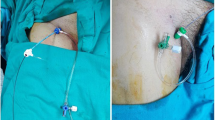Abstract
Purpose: To investigate the value of the retrograde popliteal artery approach for the percutaneous intentional extraluminal recanalization (PIER) of long superficial femoral artery (SFA) occlusions.
Methods: During a period of 17 months, PIER through ultrasound-guided retrograde popliteal artery puncture was performed for 39 long SFA occlusions in 37 patients. In six patients, six additional iliac artery stenoses were also treated via the popliteal approach.
Results: The procedure was technically successful in 32 (82%) of 39 SFA occlusions; in 29, lesions were treated with balloon angioplasty alone, and in three, stents were also used. Cumulative patency rate was 66% at 6 months, 62% at 1 year, and 59% at 18 months. Additional iliac artery stenoses were successfully treated in the same session. Complications included two minor hematomas and two SFA ruptures, which required no treatment.
Conclusion: PIER through retrograde popliteal puncture is a safe and effective method in the treatment of long femoropopliteal occlusions, with a high technical success, low complication rate and a reasonable short-term patency rate. The technique offers an alternative in cases where standard PIER is unsuccessful or contraindicated.
Similar content being viewed by others
Author information
Authors and Affiliations
Rights and permissions
About this article
Cite this article
Yilmaz, S., Sindel, T., Çeken, K. et al. Subintimal Recanalization of Long Superficial Femoral Artery Occlusions Through the Retrograde Popliteal Approach. Cardiovasc Intervent Radiol 24, 154–160 (2001). https://doi.org/10.1007/s002700001751
Published:
Issue Date:
DOI: https://doi.org/10.1007/s002700001751




